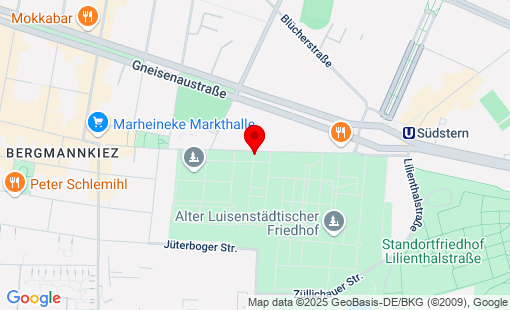Germany
Berlin-Kreuzberg, Friedrichswerderscher Friedhof II
Total Occupation: 282 fatalities
Total Occupation: 282 fatalities
Friedrichswerder Cemetery II was consecrated on January 17, 1844 as the third of four cemeteries on today's Bergmannstraße in Kreuzberg; Trinity Cemetery II has been located on its western border since 1825 and Cemetery IV of the Jerusalems and New Church parish on its eastern border since 1852. The four cemeteries are considered to be the most species-rich green spaces in Berlin with a particularly high density of breeding birds. The 3.1 hectare cemetery is the second in the municipality, but the first independent one after the first was shared with the Dorotheenstädtische Gemeinde (which therefore trades as Dorotheenstädtisch-Friedrichswerderscher Friedhof I). The resulting name confusion was resolved by the local cemetery administration by naming this cemetery Friedrichswerdersche Friedhof without numbering it. The parish church in Berlin-Mitte was built between 1824 and 1831 by Karl Friedrich Schinkel in the neo-Gothic style. After being severely damaged during the Second World War - in particular by artillery fire on April 29, 1945 - the church was preserved as a building in the 1950s and reconstructed from 1982-1987. After 1945, the congregation was absorbed into the Protestant parish in Friedrichstadt, which uses the French Cathedral on Gendarmenmarkt for its services. To celebrate Berlin's 750th anniversary in 1987, the church was reopened to the public as the Schinkel Museum, a branch of the National Gallery of East Berlin. After reunification, it was restored again in 1997-2001. In October 2012, the building was closed again as the surrounding new buildings had caused damage to the church. From 2020, the Friedrichswerdersche Kirche will once again be used for exhibitions by the Alte Nationalgalerie.
There are graves of various personalities in the cemetery:
- Hermann Clausius (1854-1925), Prussian infantry general in the First World War - Johann Friedrich Dieffenbach (1792-1847), pioneer of transplantation and plastic surgery, founder of other surgical procedures (grave of honor until 2012) - Eduard Grell (1800-1886), versatile composer (grave of honor until 2014) - Ernst von Leyden (1832-1910), Founder of the sanatorium movement to combat tuberculosis (honorary grave) - Max Missmann (1874-1945), photographer with his own studio from 1903 - Moritz Heinrich Romberg (1795-1873), doctor (for the poor) and founder of clinical neurology (honorary grave) There are also other honorary graves in the state of Berlin:
- August Selberg (1844-1935), politician and city elder - Hermann Weigand (1854-1926), architect and city elder There are also other artistically significant mausoleums and tombs, such as the mausoleum built in 1897 for the silk manufacturer Julius Heese, which is now used as a columbarium, the Art Nouveau mural for Paul Köthner, the mausoleum built in 1862 for the Seeger family or the mausoleum built in 1893 in the form of a Gothic chapel for the Spinn family of manufacturers.
Friedrichswerder Cemetery II contains a collective grave of 25 m² and 174 individual graves with victims of the Second World War, mainly civilian deaths. (Martin Bayer, 16.04.2020)
